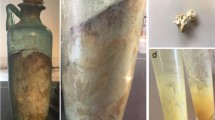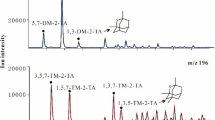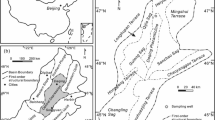Abstract
The stereochemical configuration of hopane-type triterpanes in source rock extracts or crude oils is normally determined by the maturity of the sample1. Naturally occurring precursors of the hopane hydrocarbons are dominated by the 17βH, 21βH stereochemistry with only one diastereomer at the C22 position in the C31 and higher homologues2. Note that the 17βH, 21βH-C28 homologue has never been reported in any sample. Mature crude oils in general contain hopane hydrocarbons dominated by the thermally more stable configuration of 17αH, 21βH stereochemistry and a mixture of the two diastereomers at the C22 position for C31 and higher homologues in the ratio of ∼3/2. We present here evidence for the presence of an unusual distribution of hopanes in an Australian crude oil. A study by computerized gas chromatography–mass spectrometry (C–GC–MS) designed to determine whether different oils from the same basin have similar sources has revealed the presence of the thermally unstable 17βH, 21βH isomers of hopane-type triter-panes in conjunction with C22 diastereoisomers in the unusual ratio of 1:9. We propose that there are two possible explanations for this unusual distribution of the triterpanes. (1) The oil is immature or (2) these compounds have accumulated in the oil as it migrated through coals in the region of the reservoir which are also known to contain the unusual hopane distribution.
This is a preview of subscription content, access via your institution
Access options
Subscribe to this journal
Receive 51 print issues and online access
$199.00 per year
only $3.90 per issue
Buy this article
- Purchase on Springer Link
- Instant access to full article PDF
Prices may be subject to local taxes which are calculated during checkout
Similar content being viewed by others
References
Seifert, W. K. & Moldowan, J. M. Geochim. cosmochim. Acta 45, 783–794 (1981).
Ensminger, A., Van Dorsselaer, A., Spyckerelle, Ch., Albrecht, P. & Ourisson, G. Advances in Organic Geochemistry 1973 (eds Tissot, B. & Bienner, F.) 245–260 (Editions Technip, Paris, 1974).
Philp, R. P. & Gilbert, T. D. Australian Petrol. Explor. Ass. J. 20, 221–228 (1980).
Seifert, W. K., Moldowan, J. M. & Jones, R. W. Proc. 10th World Petroleum Congr., Bucharest; Paper SP8, 425–440 (Heyden, New York, 1980).
Shi Ji-Yang et al. Chem. Geol. 35, 1–31 (1982).
Threfall, W. F., Brown, B. R., & Griffith, B. R. Economic Geology of Australia and Papua New Guinea Vol. 3 (eds Leslie, R. B., Evans, H. J. & Knight, C. L.) 41–67 (Australasian Institute of Mining and Metallurgy, Melbourne, 1976).
Van Dorsselaer, A., Albrecht, P. & Connan, J. Advances in Organic Geochemistry 1975 (eds Campos, R. & Goni, J.) 53–59 (Enadimsa, Madrid, 1977).
Seifert, W. K., & Moldowan, J. M. Advances in Organic Geochemistry 1979 (eds Douglas, A. G. & Maxwell, J. R.) 229–237 (Pergamon, Oxford, 1980).
Mackenzie, A. S., Lamb, N. A. & Maxwell, J. R. Nature 295, 223–226 (1982).
Mackenzie, A. S., Lewis, C. A. & Maxwell, J. R. Geochim. cosmochim. Acta. 45, 2369–2376 (1981).
Author information
Authors and Affiliations
Rights and permissions
About this article
Cite this article
Philp, R., Gilbert, T. Unusual distribution of biological markers in an Australian crude oil. Nature 299, 245–247 (1982). https://doi.org/10.1038/299245a0
Received:
Accepted:
Issue Date:
DOI: https://doi.org/10.1038/299245a0
This article is cited by
-
Novel tetracyclic terpanes in crude oils and source rock extracts in pearl river mouth basin and their geological significance
Journal of Earth Science (2014)
Comments
By submitting a comment you agree to abide by our Terms and Community Guidelines. If you find something abusive or that does not comply with our terms or guidelines please flag it as inappropriate.



